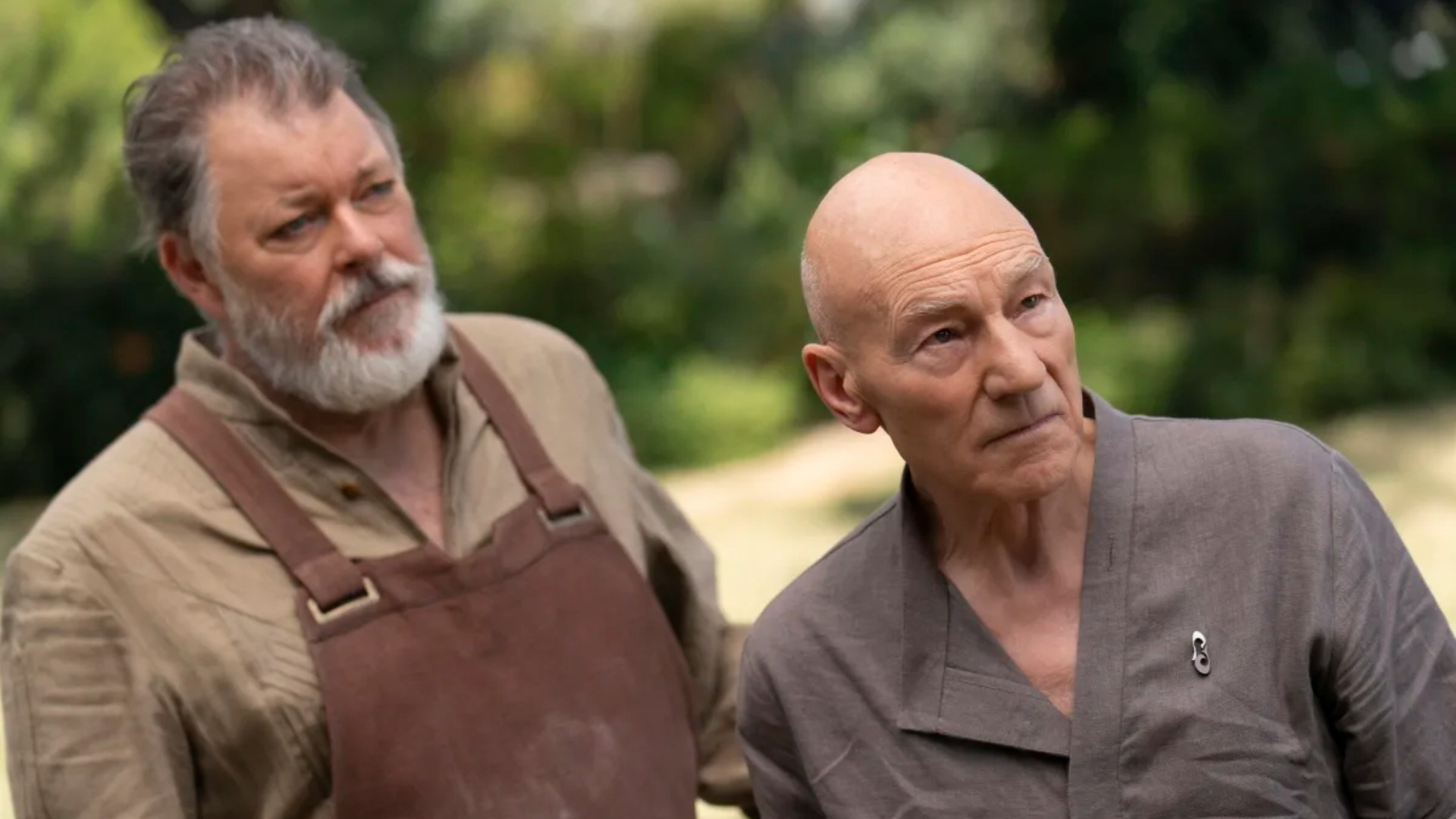GamesRadar+ Verdict
Star Trek: Picard episode 7 is the polar opposite of its predecessor, it’s every bit as brilliant
Why you can trust GamesRadar+
Warning: This Star Trek: Picard review contains major spoilers for episode 7. Turn your ship around now to avoid spoilers!
After an episode where Star Trek: Picard’s various storylines collided to spectacular effect, the talkier, more reflective “Nepenthe” is a significant slowdown. In story arc terms, it’s a brave move, but one that pays off spectacularly – while this seventh episode is the polar opposite of its predecessor, it’s every bit as brilliant, not least because Star Trek: The Next Generation fans may find themselves with watery eyes.
The destination of Picard and Soji’s escape, the planet Nepenthe (named after a drug from ancient Greek mythology) is, as we suspected, far from a random throw of the dice. It’s where Picard’s former Enterprise crewmates, Will Riker and Deanna Troi, have made their home, and it’s wonderful to see them again.
It turns out they stepped down from Starfleet (though Riker’s still on active reserve) and relocated to Nepenthe when their late son was struck down with a disease that would have been treatable were it not for the ban on synthetics – once again, this series has proved it’s not afraid of tackling real-world issues, albeit through a sci-fi filter. They’re living a quiet but apparently happy life with their teenage daughter Kestra (an excellent performance from Lulu Wilson, who played the young Shirley Crain in Netflix’s The Haunting of Hill House), with Riker doing a nice line in wood-fired pizza – he’s clearly up-to-date with the 21st-century zeitgeist.
The reunion is perfectly played, understated, and even more moving than Picard’s meeting with Hugh. That’s just how it should be, of course – Picard and Hugh only crossed paths a couple of times in TNG, while Riker, Troi, and Picard shared a starship bridge for years. This feels like old friends reuniting after years apart, though Picard is understandably reticent about telling them too much about his mission, for fear of pulling them into a fight with the Tal Shiar. Not that it matters as Riker is smart enough to work most of it out on his own.
That said, the dynamic between them has visibly shifted from the old days. Picard is no longer their commanding officer, so, for the first time, we see them interacting as equals. That’s important because it means that Troi can talk to her old captain in a way she never could on the Enterprise. (The former ship’s counsellor plays a key role in this episode, making it even more baffling that Marina Sirtis isn’t mentioned as a Special Guest Star when Jonathan Frakes is.) At times she’s practically scolding Picard for his insensitivity as he tries to get through to the emotionally damaged Soji. Indeed, along with Kestra (named after Troi’s elder sister, who died as a child), she’s the catalyst that helps build bridges between Picard and the young synthetic. They’re the ones who prove to her that someone being “sensitive and caring” is no reason to “trust [them] less”.
One of the key themes of this episode is perception and how we see other people. We’re so used to seeing Picard as the hero and voice of reason that we just assume he’s the good guy – Riker clearly feels this way and is visibly agitated when Soji doesn’t agree with his view that he’s the “greatest Starfleet captain ever”. But for Soji, betrayed so spectacularly by former lover Narek, there’s no reason to trust this strange old man who arrived from nowhere and whisked her away from the Borg Cube. For her, it’s a fine line between rescue and abduction.
Picard has to deploy all his finest diplomatic skills to win her over and make her believe what he’s saying, imploring her to listen to the timbre of his voice, look at the pupils in his eyes, and feel his heartbeat – the reference to its mechanical nature is a callback to TNG episode “Tapestry”, which details a near-fatal accident in Picard’s formative years. It’s also important that we get to see a glimpse of what Riker describes as “classic Picard arrogance”, as Jean-Luc states firmly that he’s alive, has a mission, and that nobody can stop him. We’re not going to argue with him on that.
Over on La Sirena, Picard’s new crew continue to “carry more baggage” than his old Enterprise colleagues ever did, particularly Dr Jurati who’s having so much trouble dealing with her demons that not even red velvet cake and chocolate milk can help. At least we’ve now learned why she was prepared to kill Maddox. Star Trek: Picard is brilliant at knowing when to drip-feed information, and here a flashback reveals that a mind meld from Commodore Oh showed Jurati a future of bloodied Romulan/Vulcan faces and exploding planets (Earth, we’re guessing). The question is, where have these images come from? Has Oh seen the future, or is it an elaborate hoax? Either way, the vision is enough to prompt Jurati to join Picard’s adventure, kill Maddox, and bite down on a pill containing a tracking device.
Dealing with the beacon is the main order of the day in this particular sector of the galaxy – it’s definitely the B-plot, but provides an important counterpoint to the chat over on Nepenthe. It’s a particularly easy episode for Harry Treadaway, who spends its duration in a small Romulan craft in pursuit of La Sirena – his most notable act is a passable imitation of Boba Fett tracking the Millennium Falcon, quietly lurking as his quarry escapes the orbit of the Borg Cube.
As Rios and Raffi try to work out how to shake their troublesome shadow, suspicions start to grow. Raffi is the perceptive one, pointing out the contradiction that Jurati was initially obsessed with the idea of meeting a Data-like android, yet – the closer they get to finding Soji – the more she wants to go home. Rios, meanwhile, is totally wrong in his guess that Raffi is the one allowing La Sirena to be tracked. Jurati’s extreme solution to the problem, injecting herself with poisonous uranium hydride, may have stopped that particular debate – the tracker is now disabled, with the unfortunate side effect that she’s now in a coma.
Finally, we have to mention the events on the Borg Cube where Hugh’s diplomatic immunity from the Romulans can only last so long. Narek’s evil big sister shows little hesitation in killing reclaimed Borg to force Hugh into revealing Picard and Soji’s whereabouts. It works – in a roundabout way – as Hugh subsequently slips up by telling Elnor his plans to take over the Cube. That’s all the excuse the Zhat Vash agent needs to murder Hugh – considering he’s only appeared in half a dozen episodes of Trek, it’s a remarkably heartbreaking moment – and she beams out before Elnor gets the chance to strike her down. With the future of the ex-Borg now in his hands, Elnor looks set to have a much bigger role to play than simply being Jean-Luc’s bodyguard.
New episodes of Star Trek: Picard appear in the US on Thursdays on CBS All Action, and in the UK on Fridays on Amazon Prime Video.
Richard is a freelancer journalist and editor, and was once a physicist. Rich is the former editor of SFX Magazine, but has since gone freelance, writing for websites and publications including GamesRadar+, SFX, Total Film, and more. He also co-hosts the podcast, Robby the Robot's Waiting, which is focused on sci-fi and fantasy.




